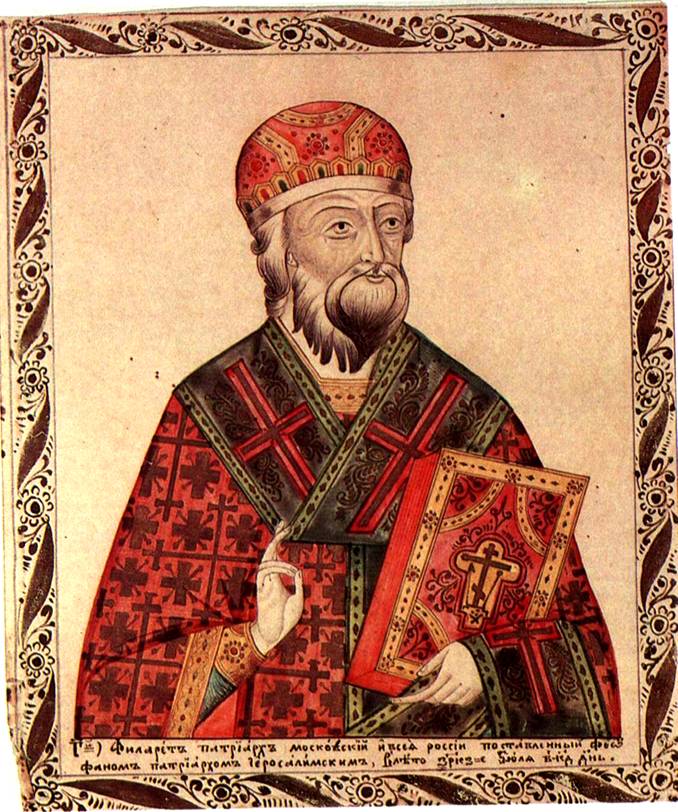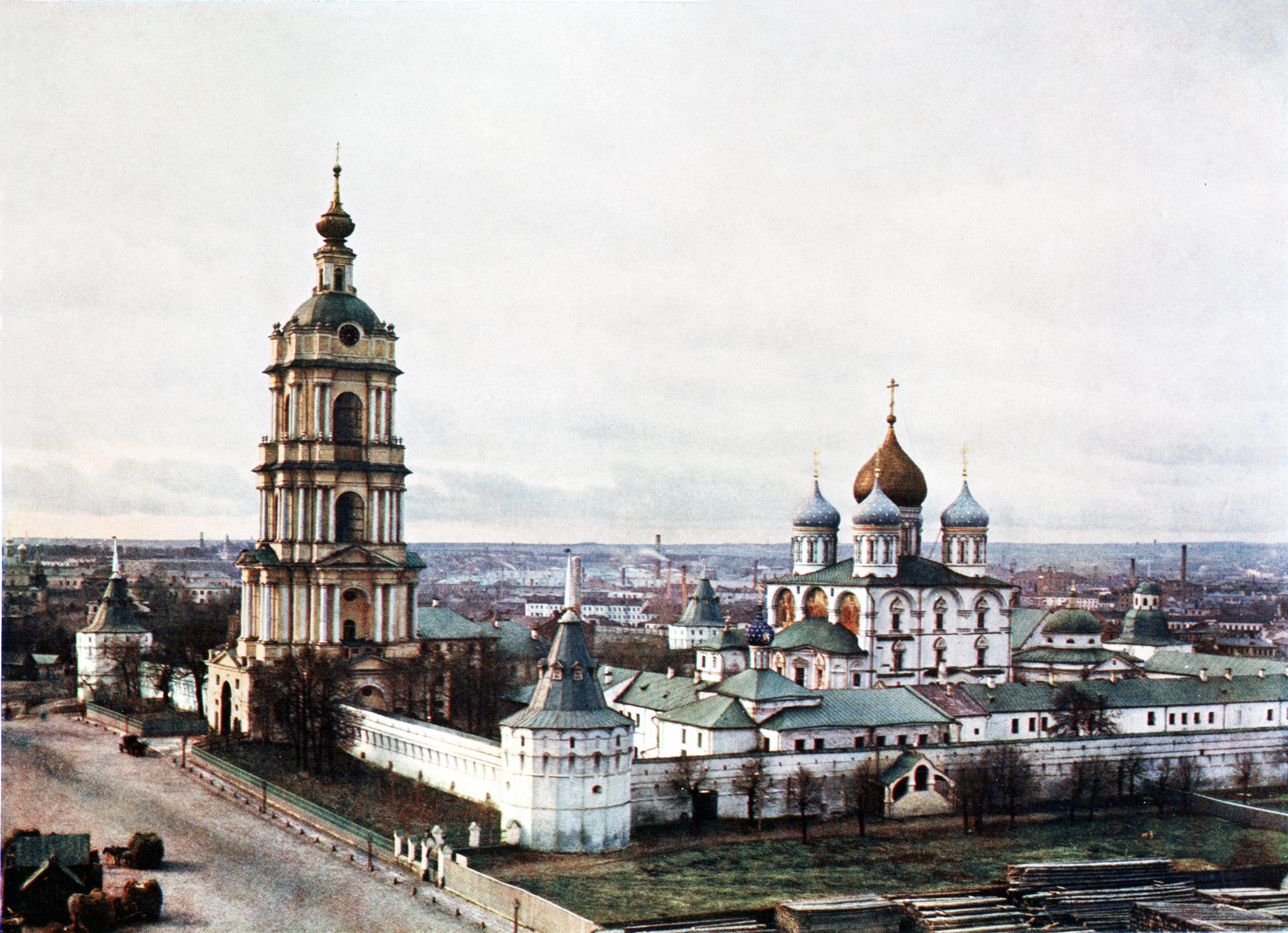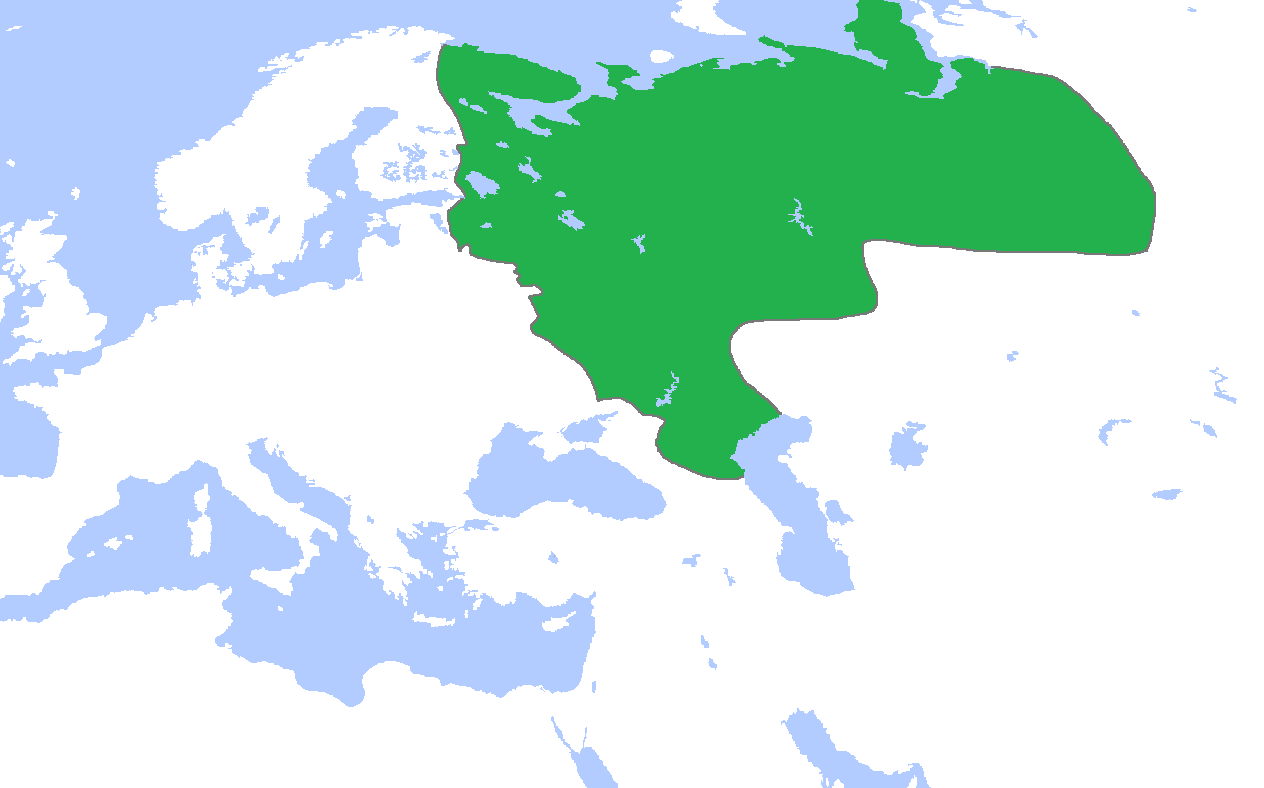|
Kseniya Ivanovna Shestova
Boyarinya Kseniya Ioannovna (Ivanovna) Shestova (russian: Ксения Ивановна Шестова (or Романова); 1560–1631) was a spouse of Fyodor Romanov and the mother of Mikhail Romanov. Life The origins of Xeniya Ivanovna have been disputed by genealogists for centuries. It is currently accepted that her surname was Shestova (Шестова; rather than Shastunova, as was previously believed) and that her grandfather was Timofey Gryaznoy, a rich landowner from Uglich. During Boris Godunov's repression of the Romanovs, she was forced to take the veil, changing her name to Martha (Russian: Марфа). After several years of exile at Tolvuyskiy pogost, she settled with her son in Kostroma. It was there that the ambassadors arrived to inform Mikhail about his election to the Russian throne in 1613. As the previous tsars had been Time of Troubles, either killed or disgraced, Martha at first declined to bless her son and let him go to Moscow. During the first years ... [...More Info...] [...Related Items...] OR: [Wikipedia] [Google] [Baidu] |
Fyodor Romanov
Feodor Nikitich Romanov (russian: Фео́дор Ники́тич Рома́нов, ; 1553 – 1 October 1633) was a Russian boyar who after temporary disgrace rose to become patriarch of Moscow as Filaret (russian: Филаре́т, ), and became de facto ruler of Russia during the reign of his son, Mikhail Feodorovich. Biography The second son of the prominent boyar Nikita Romanovich, Feodor was born in Moscow and was the first to bear the Romanov surname. During the reign of his first cousin Feodor I (1584–1598), young Feodor Romanov distinguished himself both as a soldier and a diplomat, fighting against the forces of John III of Sweden in 1590, and conducting negotiations with the ambassadors of Rudolf II, Holy Roman Emperor from 1593 to 1594. He was made a boyar in 1583. On the death of the childless tsar, he was the popular candidate for the vacant throne; but he acquiesced in the election of Boris Godunov, and shared the disgrace of his too-powerful family three ... [...More Info...] [...Related Items...] OR: [Wikipedia] [Google] [Baidu] |
Time Of Troubles
The Time of Troubles (russian: Смутное время, ), or Smuta (russian: Смута), was a period of political crisis during the Tsardom of Russia which began in 1598 with the death of Fyodor I (Fyodor Ivanovich, the last of the Rurik dynasty) and ended in 1613 with the accession of Michael I of the House of Romanov. It was a time of lawlessness and anarchy following the death of Fyodor I, a weak and possibly intellectually disabled ruler who died without an heir. His death ended the Rurik dynasty, leading to a violent succession crisis with numerous usurpers and false Dmitrys (imposters) claiming the title of tsar. Russia experienced the famine of 1601–03, which killed almost a third of the population, within three years of Fyodor's death. Russia was occupied by the Polish–Lithuanian Commonwealth during the Polish–Russian War (also known as the ''Dimitriads'') until it was expelled in 1612. It was one of the most turbulent and violent periods in Russian history. ... [...More Info...] [...Related Items...] OR: [Wikipedia] [Google] [Baidu] |
House Of Romanov
The House of Romanov (also transcribed Romanoff; rus, Романовы, Románovy, rɐˈmanəvɨ) was the reigning imperial house of Russia from 1613 to 1917. They achieved prominence after the Tsarina, Anastasia Romanova, was married to the First Tsar of Russia, Ivan the Terrible. The house became '' boyars'' (the highest rank in Russian nobility'')'' of the Grand Duchy of Moscow and later of the Tsardom of Russia under the reigning Rurik dynasty, which became extinct upon the death of Tsar Feodor I in 1598. The Time of Troubles, caused by the resulting succession crisis, saw several pretenders and imposters ( False Dmitris) fight for the crown during the Polish–Muscovite War of 1605–1618. On 21 February 1613, a ''Zemsky Sobor'' elected Michael Romanov as Tsar of Russia, establishing the Romanovs as Russia's second reigning dynasty. Michael's grandson Peter I, who established the Russian Empire in 1721, transformed the country into a great power through a series of ... [...More Info...] [...Related Items...] OR: [Wikipedia] [Google] [Baidu] |
1631 Deaths
Events January–March * January 23 – Thirty Years' War: Sweden and France sign the Treaty of Bärwalde, a military alliance in which France provides funds for the Swedish army invading northern Germany. * February 5 – Puritan leader Roger Williams arrives in Boston. * February 16 – The Reval Gymnasium is founded in Tallinn, Estonia, by Swedish king Gustavus II Adolphus. * February 20 – A fire breaks out in Westminster Hall, but is put out before it can cause serious destruction."Fires, Great", in ''The Insurance Cyclopeadia: Being an Historical Treasury of Events and Circumstances Connected with the Origin and Progress of Insurance'', Cornelius Walford, ed. (C. and E. Layton, 1876) p29 * March 7 – Ambrósio I Nimi a Nkanga, the ruler of the Kingdom of Kongo (in what is now Angola) dies after a reign of five years. * March 10 – Al Walid ben Zidan becomes the new Sultan of Morocco upon the death of Abu Marwan Abd al-Mal ... [...More Info...] [...Related Items...] OR: [Wikipedia] [Google] [Baidu] |
1560 Births
Year 156 ( CLVI) was a leap year starting on Wednesday (link will display the full calendar) of the Julian calendar. At the time, it was known as the Year of the Consulship of Silvanus and Augurinus (or, less frequently, year 909 ''Ab urbe condita''). The denomination 156 for this year has been used since the early medieval period, when the Anno Domini calendar era became the prevalent method in Europe for naming years. Events By place America * The La Mojarra Stela 1 is produced in Mesoamerica. By topic Religion * The heresiarch Montanus first appears in Ardaban (Mysia). Births * Dong Zhao, Chinese official and minister (d. 236) * Ling of Han, Chinese emperor of the Han Dynasty (d. 189) * Pontianus of Spoleto, Christian martyr and saint (d. 175) * Zhang Zhao, Chinese general and politician (d. 236) * Zhu Zhi, Chinese general and politician (d. 224) Deaths * Marcus Gavius Maximus, Roman praetorian prefect * Zhang Daoling, Chinese Taoist master (b. AD 3 ... [...More Info...] [...Related Items...] OR: [Wikipedia] [Google] [Baidu] |
Brockhaus And Efron Encyclopedic Dictionary
The ''Brockhaus and Efron Encyclopaedic Dictionary'' (Russian: Энциклопедический словарь Брокгауза и Ефрона, abbr. ЭСБЕ, tr. ; 35 volumes, small; 86 volumes, large) is a comprehensive multi-volume encyclopaedia in Russian. It contains 121,240 articles, 7,800 images, and 235 maps. It was published in Imperial Russia in 1890–1907, as a joint venture of Leipzig and St Petersburg publishers. The articles were written by the prominent Russian scholars of the period, such as Dmitri Mendeleev and Vladimir Solovyov. Reprints have appeared following the dissolution of the Soviet Union. History In 1889, the owner of one of the St. Petersburg printing houses, Ilya Abramovich Efron, at the initiative of Semyon Afanasyevich Vengerov, entered into an agreement with the German publishing house F. A. Brockhaus for the translation into Russian of the large German encyclopaedic dictionary ( de) into Russian as , published by the same publishin ... [...More Info...] [...Related Items...] OR: [Wikipedia] [Google] [Baidu] |
Romanov Dynasty
The House of Romanov (also transcribed Romanoff; rus, Романовы, Románovy, rɐˈmanəvɨ) was the reigning imperial house of Russia from 1613 to 1917. They achieved prominence after the Tsarina, Anastasia Romanova, was married to the First Tsar of Russia, Ivan the Terrible. The house became ''boyars'' (the highest rank in Russian nobility'')'' of the Grand Duchy of Moscow and later of the Tsardom of Russia under the reigning Rurik dynasty, which became extinct upon the death of Tsar Feodor I in 1598. The Time of Troubles, caused by the resulting succession crisis, saw several pretenders and imposters ( False Dmitris) fight for the crown during the Polish–Muscovite War of 1605–1618. On 21 February 1613, a '' Zemsky Sobor'' elected Michael Romanov as Tsar of Russia, establishing the Romanovs as Russia's second reigning dynasty. Michael's grandson Peter I, who established the Russian Empire in 1721, transformed the country into a great power through a series of ... [...More Info...] [...Related Items...] OR: [Wikipedia] [Google] [Baidu] |
Our Lady Of St
Our or OUR may refer to: * The possessive form of " we" * Our (river), in Belgium, Luxembourg, and Germany * Our, Belgium, a village in Belgium * Our, Jura, a commune in France * Office of Utilities Regulation (OUR), a government utility regulator in Jamaica * Operation Underground Railroad, a non-profit organization that helps rescue sex trafficking victims * Operation Unified Response, the United States military's response to the 2010 Haiti earthquake * Ownership, Unity and Responsibility Party The Ownership, Unity and Responsibility Party (or Our Party) is a political party in the Solomon Islands. The party was established on 16 January 2010 (and officially launched a month later) by the leader of the Opposition (and former Prime Minis ..., a political party in the Solomon Islands See also * Ours (other) {{Disambiguation, geo ... [...More Info...] [...Related Items...] OR: [Wikipedia] [Google] [Baidu] |
Kostroma
Kostroma ( rus, Кострома́, p=kəstrɐˈma) is a historic city and the administrative center of Kostroma Oblast, Russia. A part of the Golden Ring of Russian cities, it is located at the confluence of the rivers Volga and Kostroma. Population: History Under the Rurikids The official founding year of the city is 1152 by Yury Dolgoruky.Official website of KostromaKostroma Today/ref> Since many scholars believe that early Eastern Slavs tribes arrived in modern-day Belarus, Ukraine and western Russia AD 400 to 600, Kostroma could be much older than previously thought. The city has the same name as the East Slavic goddess Kostroma. Like other towns of the Eastern Rus, Kostroma was sacked by the Mongols in 1238. It then constituted a small principality, under leadership of Prince Vasily of Kostroma, a younger brother of the famous Alexander Nevsky. Upon inheriting the grand ducal title in 1271, Vasily didn't leave the town for Vladimir, and his descendants ruled Kostroma ... [...More Info...] [...Related Items...] OR: [Wikipedia] [Google] [Baidu] |
Novospassky Monastery
Novospassky Monastery (''New Monastery of the Savior'', russian: Новоспасский монастырь) is one of the fortified monasteries surrounding Moscow from the south-east. Like all medieval Russian monasteries, it was built by the Russian Orthodox Church. The abbey traces its history back to Moscow's first monastery established in the early 14th century at the location where the Danilov Monastery now stands. The Church of the Savior in the Wood (Собор Спаса на Бору) of the Kremlin, the oldest church of Moscow, was its original katholikon. Upon its removal to the left bank of the Moskva River in 1491, the abbey was renamed ''Abbey of the New Savior'', to distinguish it from the older one in the Kremlin. The monastery was patronized by Andrei Kobyla's descendants, including the Sheremetev and Romanov boyars, and served as their burial vault. Among the last Romanovs buried in the monastery were Xenia Shestova (the mother of the first Romanov Tsar), Pri ... [...More Info...] [...Related Items...] OR: [Wikipedia] [Google] [Baidu] |
Pogost
''Pogost'' (russian: погост, from Old East Slavic: погостъ) is a historical term with several meanings in the Russian language. It has also been borrowed into Latgalian (''pogosts''), Finnish (''pogosta'') and Latvian (''pagasts''), with specific meanings. The original usage applies to the coaching inn for princes and ecclesiastics with the word being similar to modern Russian ''gost (гость), "guest". It is assumed that originally ''pogosts'' were rural communities on the periphery of the ancient Rus` state, as well as trading centers (Old Russian: ''gost'ba'', гостьба). In the end of the 10th century ''pogosts'' transformed into administrative and territorial districts. ''Pogosts'' varied in size, ranging from tens to hundreds of villages in 11th—14th centuries. As Christianity spread in Russia, churches were built in ''pogosts''. In 1775 the last ''pogosts'' that served as administrative districts were destroyed. Since then they became known as cit ... [...More Info...] [...Related Items...] OR: [Wikipedia] [Google] [Baidu] |
Boris Godunov
Borís Fyodorovich Godunóv (; russian: Борис Фёдорович Годунов; 1552 ) ruled the Tsardom of Russia as ''de facto'' regent from c. 1585 to 1598 and then as the first non-Rurikid tsar from 1598 to 1605. After the end of his reign, Russia descended into the Time of Troubles. Early years Boris Godunov was the most noted member of an ancient, now extinct, Russian family of Tatar origin ( Chet), which came from the Horde to Kostroma in the early 14th century. This cites: * Platon Vasilievich Pavlov, ''On the Historical Significance of the Reign of Boris Godunov'' (Rus.) (Moscow, 1850) * Sergyei Mikhailivich Solovev, ''History of Russia'' (Rus.) (2nd ed., vols. vii–viii., St Petersburg, 1897). This legend is written in the annals dating from early 17th century. He was descended from the Tatar Prince Chet, who went from the Golden Horde to Russia and founded the Ipatiev Monastery in Kostroma. Boris was probably born before or after the Kazan campaign. Boris was ... [...More Info...] [...Related Items...] OR: [Wikipedia] [Google] [Baidu] |






